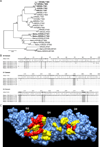KIR3DL01 recognition of Bw4 ligands in the rhesus macaque: maintenance of Bw4 specificity since the divergence of apes and Old World monkeys
- PMID: 24453246
- PMCID: PMC4162532
- DOI: 10.4049/jimmunol.1302883
KIR3DL01 recognition of Bw4 ligands in the rhesus macaque: maintenance of Bw4 specificity since the divergence of apes and Old World monkeys
Abstract
The identification of MHC class I ligands for rhesus macaque killer cell Ig-like receptors (KIRs) is fundamental to our basic understanding of KIR and MHC class I coevolution and to the study of NK cell responses in this nonhuman primate model for AIDS and other viral diseases. In this study, we show that Mamu-KIR3DL01, which is expressed by ∼90% of rhesus macaques, recognizes MHC class I molecules with a Bw4 motif. Primary NK cells expressing Mamu-KIR3DL01 were identified by staining with a mAb which, in this study, was shown to bind Mamu-KIR3DL01 allotypes with an aspartic acid at position 233. The cytolytic activity of Mamu-KIR3DL01(+) NK cells was suppressed by cell lines expressing the Bw4 molecules Mamu-B*007:01, -B*041:01, -B*058:02, and -B*065:01. The Bw4 motif was necessary for Mamu-KIR3DL01 recognition because substitutions in this region abrogated Mamu-KIR3DL01(+) NK cell inhibition. However, the presence of a Bw4 motif was not sufficient for recognition because another Bw4 molecule, Mamu-B*017:01, failed to suppress the cytolytic activity of these NK cells. Replacement of three residues in Mamu-B*017:01, predicted to be KIR contacts based on the three-dimensional structure of the human KIR3DL1-HLA-Bw4 complex, with the corresponding residues at these positions for the other Mamu-Bw4 ligands restored Mamu-KIR3DL01(+) NK cell inhibition. These results define the ligand specificity of one of the most polymorphic and commonly expressed KIRs in the rhesus macaque and reveal similarities in Bw4 recognition by Mamu-KIR3DL01 and human KIR3DL1, despite the absence of an orthologous relationship between these two KIRs or conservation of surface residues predicted to interact with MHC class I ligands.
Figures







Similar articles
-
Diversification of Bw4 Specificity and Recognition of a Nonclassical MHC Class I Molecule Implicated in Maternal-Fetal Tolerance by Killer Cell Ig-like Receptors of the Rhesus Macaque.J Immunol. 2018 Nov 1;201(9):2776-2786. doi: 10.4049/jimmunol.1800494. Epub 2018 Sep 19. J Immunol. 2018. PMID: 30232137 Free PMC article.
-
MHC Class I Ligands of Rhesus Macaque Killer Cell Ig-like Receptors.J Immunol. 2023 Jun 1;210(11):1815-1826. doi: 10.4049/jimmunol.2200954. J Immunol. 2023. PMID: 37036309 Free PMC article.
-
KIR3DL01 upregulation on gut natural killer cells in response to SIV infection of KIR- and MHC class I-defined rhesus macaques.PLoS Pathog. 2017 Jul 14;13(7):e1006506. doi: 10.1371/journal.ppat.1006506. eCollection 2017 Jul. PLoS Pathog. 2017. PMID: 28708886 Free PMC article.
-
The killer-cell immunoglobulin-like receptors of macaques.Immunol Rev. 2015 Sep;267(1):246-58. doi: 10.1111/imr.12329. Immunol Rev. 2015. PMID: 26284482 Free PMC article. Review.
-
KIR specificity and avidity of standard and unusual C1, C2, Bw4, Bw6 and A3/11 amino acid motifs at entire HLA:KIR interface between NK and target cells, the functional and evolutionary classification of HLA class I molecules.Int J Immunogenet. 2019 Aug;46(4):217-231. doi: 10.1111/iji.12433. Epub 2019 Jun 18. Int J Immunogenet. 2019. PMID: 31210416 Review.
Cited by
-
Diversification of both KIR and NKG2 natural killer cell receptor genes in macaques - implications for highly complex MHC-dependent regulation of natural killer cells.Immunology. 2017 Feb;150(2):139-145. doi: 10.1111/imm.12666. Epub 2016 Oct 5. Immunology. 2017. PMID: 27565739 Free PMC article. Review.
-
Co-evolution of MHC class I and variable NK cell receptors in placental mammals.Immunol Rev. 2015 Sep;267(1):259-82. doi: 10.1111/imr.12326. Immunol Rev. 2015. PMID: 26284483 Free PMC article. Review.
-
The Genetic Mechanisms Driving Diversification of the KIR Gene Cluster in Primates.Front Immunol. 2020 Sep 11;11:582804. doi: 10.3389/fimmu.2020.582804. eCollection 2020. Front Immunol. 2020. PMID: 33013938 Free PMC article. Review.
-
The evolution of natural killer cell receptors.Immunogenetics. 2016 Jan;68(1):3-18. doi: 10.1007/s00251-015-0869-7. Epub 2015 Sep 21. Immunogenetics. 2016. PMID: 26392015 Free PMC article. Review.
-
Impact of CMV Infection on Natural Killer Cell Clonal Repertoire in CMV-Naïve Rhesus Macaques.Front Immunol. 2019 Oct 9;10:2381. doi: 10.3389/fimmu.2019.02381. eCollection 2019. Front Immunol. 2019. PMID: 31649681 Free PMC article.
References
-
- Huard B, Fruh K. A role for MHC class I down-regulation in NK cell lysis of herpes virus-infected cells. Eur. J. Immunol. 2000;30:509–515. - PubMed
-
- Falk CS, Mach M, Schendel DJ, Weiss EH, Hilgert I, Hahn G. NK cell activity during human cytomegalovirus infection is dominated by US2-11-mediated HLA class I down-regulation. J. Immunol. 2002;169:3257–3266. - PubMed
-
- Cohen GB, Gandhi RT, Davis DM, Mandelboim O, Chen BK, Strominger JL, Baltimore D. The selective downregulation of class I major histocompatibility complex proteins by HIV-1 protects HIV-infected cells from NK cells. Immunity. 1999;10:661–671. - PubMed
-
- Schwartz O, Marechal V, Le Gall S, Lemonnier F, Heard JM. Endocytosis of major histocompatibility complex class I molecules is induced by the HIV-1 Nef protein. Nat. Med. 1996;2:338–342. - PubMed
-
- Collins KL, Chen BK, Kalams SA, Walker BD, Baltimore D. HIV-1 Nef protein protects infected primary cells against killing by cytotoxic T lymphocytes. Nature. 1998;391:397–401. - PubMed
Publication types
MeSH terms
Substances
Grants and funding
LinkOut - more resources
Full Text Sources
Other Literature Sources
Research Materials

